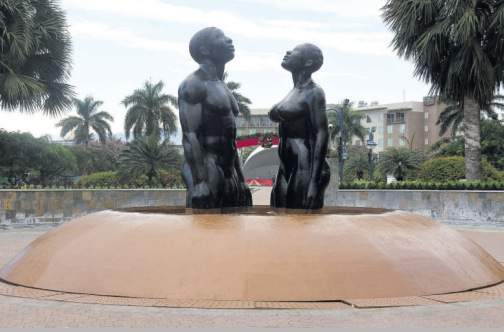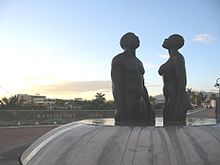BY RICHARD JOHNSON–
Observer senior reporter–

Artist Laura Facey (photos: Naphtali Junior)
In 2002 the Government of Jamaica opened Emancipation Park, an expansive green space located in the heart of the Corporate Area.
One of the central features of the park is the imposing statue Redemption Songcreated by artist Laura Facey. However when the statue — two nude figures, male and female, facing each other and looking to the skies — was unveiled, there was a firestorm of controversy.
For some, the sheer size of the monument depicting nude persons was offensive to their sensibilities.
In wake of the controversy the artist said she retreated, shying away from taking on her staunchest critics, some of who said she was not of the social standing, colour or race to have the sensibility to represent the horrors of slavery and the joys of emancipation. But Facey thought otherwise.
Seventeen years later, Facey is ready to face her critics and has chosen the medium of film to share the back story behind Redemption Song and her other works which capture the slavery experience. She has partnered with Spanish film-maker Amanda Sans to produce a moving short film which explains her perspective and why, through her own personal pain and trauma, she is able to identify with the slave experience.

In the film premièred locally last Thursday in front of a full house at Palace Cineplex in St Andrew, it was disclosed that Facey has been sexually abused on three separate occasions in her life. She explained that she was inappropriately touched at age 9, then raped at age 19, and again at 33.
However, as she explained in the film, subconsciously her work would showcase her pain. She noted that she chose odd titles to obscure the deeper meaning of the work. Early pieces such as Broken Open, Paper Gods and Moonshine Baby carry the recurring motif of mangled bodies, and the sense of detachment Facey buried deep, due to her traumatic past.
Through prayer, meditation and the study of metaphysics, Facey began to unlock her pain and the first work to reflect her work in transforming herself was the larger-than-life, aptly titled 8-foot x 12-foot Goddess of Change.

Then came Redemption Song.
Facey had seen a call of submissions in the newspaper and gave it a try. Once she was accepted, she had a year to produce the work.
“I wanted impact; it had to be of a certain size. Making it large was important. I wanted to share my own transformation instead of sad, grumpy and miserable. I wanted to feel released,” she said of the now popular work and Kingston landmark.

“That is why the figures are full and whole in themselves, nothing to be ashamed of,” she further explained to the Jamaica Observer.
“Life is always a work in progress and I’m still working on myself and slavery. With Redemption Song , which was my first slavery piece, my work has become more prayerful… more conscious. That’s a huge difference, but I’m still working and growing spiritually as a person and I’m still dreaming up pieces that are related to slavery… it’s in my blood, in my bones.”
Facey hopes the film will help the critics of Redemption Song to see where she was coming from when she created the work.
“Everytime I speak with people I see a softening and understanding. I was having a conversation and someone told me quite fiercely that they hated it, but by the time we finished our conversation it’s like their mind became more open,” said Facey.

